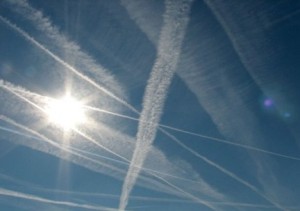5th December 2011
By Rady Ananda – globalresearch.ca
Suffolk Co. NY to hear proposal to ban chemtrails
On Dec. 6, New York’s Suffolk County government will hold a public hearing on a proposal to ban aerial spraying of aluminum oxide, barium, sulfur, and other salts into the air over the county without first filing an Environmental Impact Statement with and receiving approval from the county’s Department of Health Services, Division of Environmental Quality.
Exempted from the proposed ban are aerosol spraying operations for agriculture, and for lyme disease, Eastern equine encephalitis (EEE), West Nile virus (WNV), and other disease vector control operations.
The hearing will be held at the Riverhead Legislative Auditorium, Evans K. Griffing Building, 300 Center Drive in Riverhead, NY at 2:30 pm.
If the public is able to convince legislators of the risk from such geoengineering operations, the legislation will then be voted on at the Dec. 20th session. Otherwise, the proposed ban will be tabled indefinitely.
Initiated by Cindy Pikoulas and her husband Jim, along with Siobhan Ciresi of Long Island Sky Watch (LISW), with the assistance of chemtrail opponent Rosalind Peterson of Agriculture Defense Coalition, the bill was finalized and proposed by legislator Edward P. Romaine (1st District). (Full text below.)
Involved in Suffolk County government since 1989, Romaine is a fiscal conservative who prioritizes saving farmland and protecting the environment. In August, he organized Long Island’s first countywide farmers market, along with the Long Island Farm Bureau.
Romaine has represented the 1st District (eastern end of Long Island) continuously since 2005. He serves on the Environment, Planning & Agriculture Committee, which voted on Nov. 28 to submit the proposed law banning such aerial spraying to a public hearing.
The Piloulases and Ciresi will speak on Dec. 6 and are urging people to “pack the hearing” to show support for the ban.
“If this proposal becomes law in Suffolk County, Long Island, it would be the first in the nation. It would be a starting point for others to follow,” said LISW in a press release.
“Eventually, our governments would have to investigate why our trees are dying in record numbers; why our waters contain toxic levels of aluminum, barium and strontium; why 90% of us are vitamin D deficient; why our crops are failing; and where all of this crazy weather is coming from.”
Cindy Pikoulas of LISW spoke with New York Sky Watch radio on Nov. 20, when she advised that tree samples from Suffolk show high levels of barium, strontium and aluminum. She is asking Long Islanders to have their water and trees tested for these chemicals in order to build a body of evidence that would spur investigations by health and environment authorities.
In addition to attending the Dec. 6 hearing, Long Islanders can contact their county legislators via http://legis.suffolkcountyny.gov/legislators.html
Are Exemptions Necessary?
Though exempted under the proposed ban, disease vector spraying may be a subterfuge for weather control operations, given the extreme rarity of EEV and WNV. According to the U.S. Dept of Health and Human Services:
“Eastern equine encephalitis (EEE) is a rare but serious viral disease caused by a virus transmitted by the bite of an infected mosquito with more severe symptoms than for West Nile virus. EEE is an arbovirus (short for arthropod-borne, meaning spread by insects). Birds are the source of infection for mosquitoes, which can sometimes transmit the infection to horses, other animals, and, in rare cases, people.
“West Nile Virus (WNV) was first seen in the US in 1999, in the New York City area of Queens. WNV can live in a number of types of birds and is passed bird to bird by certain types of mosquitoes. Occasionally, an infected mosquito will pass the virus to humans or other animals. Most healthy people do not get sick from the virus, but sometimes it may cause symptoms.”
Per the US Geological Survey, two horses caught WNV in 2011 and 12 caught EEE, none of them in Suffolk. Of humans, 43 contracted WNV in New York State in 2011, four of them in Suffolk County. Only one person contracted EEE in the entire state.
Of the other vector-borne diseases of concern to health authorities – St Louis Encephalitis, La Crosse Encephalitis, Powassan Virus, and locally-acquired Dengue Fever – no New Yorkers contracted any of them in 2011. (But 40 New Yorkers did contract Dengue Fever when traveling outside the US in 2011.)
Considering that the population of NYS is 19 million, the application of toxic chemicals purportedly to control for such rare vector-borne diseases where only 44 people became ill in 2011 seems absurd.
US health officials admit that Ugandans and Egyptians, where WNV was first discovered, develop a natural immunity before reaching adulthood. Using toxic chemicals that pollute the environment, leading to cancer and respiratory diseases, instead of allowing humans to develop immunity to such diseases, is an unsustainable and irresponsible control method.
Whether these vector control spray programs are involved in other activities such as solar radiation or rainfall management is uncertain. But, in addition to the obvious jets laying chemtrails at 30,000 feet, they may be involved in contributing to the high levels of aluminum, barium and strontium found in Suffolk waters and trees.
Click here for the full text of Suffolk’s proposed legislation (scroll 1/2 way down the page)
About the Author
Rady Ananda’s work has appeared in several online and print publications. She holds a B.S. in Natural Resources from The Ohio State University’s School of Agriculture. Using years of editorial experience and web publishing, Rady now promotes the ideas and work of a select group of quality writers and artists at Food Freedom and COTO Report.

If you've ever found value in our articles, we'd greatly appreciate your support by purchasing Mindful Meditation Techniques for Kids - A Practical Guide for Adults to Empower Kids with the Gift of Inner Peace and Resilience for Life.
In the spirit of mindfulness, we encourage you to choose the paperback version. Delve into its pages away from screen glare and notifications, allowing yourself to fully immerse in the transformative practices within. The physical book enriches the learning process and serves as a tangible commitment to mindfulness, easily shared among family and friends.
Over the past few years, Wake Up World has faced significant online censorship, impacting our financial ability to stay online. Instead of soliciting donations, we're exploring win-win solutions with our readers to remain financially viable. Moving into book publishing, we hope to secure ongoing funds to continue our mission. With over 8,500 articles published in the past 13 years, we are committed to keeping our content free and accessible to everyone, without resorting to a paywall.







